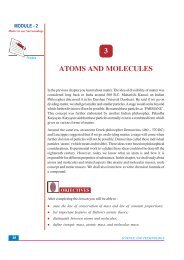NIOS : The Way Forward - The National Institute of Open Schooling
NIOS : The Way Forward - The National Institute of Open Schooling
NIOS : The Way Forward - The National Institute of Open Schooling
You also want an ePaper? Increase the reach of your titles
YUMPU automatically turns print PDFs into web optimized ePapers that Google loves.
4<br />
<strong>NIOS</strong>: <strong>The</strong> <strong>Way</strong> <strong>Forward</strong> / 33<br />
Curriculum Transaction Processes<br />
Learning to Learn and Learning Supports<br />
Through a careful integration <strong>of</strong> lessons that are mainly self instructional, with<br />
the additional supports provided through Personal Contact Programmes, and<br />
through the use <strong>of</strong> audio and video materials, the distance learner <strong>of</strong> <strong>NIOS</strong><br />
has the opportunity to learn differently and to learn more effectively.<br />
4.1 Instructional Process<br />
4.2 Learning made effective through<br />
inter-linked support packages<br />
4.3 Regional Centres and Study<br />
Centres<br />
4.4 Personal Contact Programmes<br />
(PCP)<br />
4.5 Mind Maps<br />
4.6 Summing up<br />
4.1 Instructional Process<br />
Instruction in <strong>NIOS</strong> is a planned and a<br />
deliberate attempt is made to help the<br />
learner assimilate and consolidate the<br />
learning experiences. <strong>The</strong> critical<br />
elements are the learner, the learning<br />
experiences and the learning context. To<br />
support and supplement, there are the<br />
teachers, the study materials and the<br />
teaching methodology. In any transaction<br />
process nothing can be “ given” to the<br />
learner. It is the learner who must “pick” up the message. It is the learner who<br />
must “make” meaning out <strong>of</strong> it and it is the learner who constructs knowledge.<br />
While in the face-to-face system, the teacher plays an important role in the<br />
instructional process, in ODL, the instructional package and its several support<br />
systems make key contributions. <strong>The</strong> learner is more autonomous in ODL<br />
than in the conventional mode. Rather than the teacher, it is the “teacher-inprint”<br />
who plays a key role in ODL.<br />
4.2 Learning made effective through inter-linked support packages<br />
By referring to Figure 3.2, one can readily understand why the lesson is called<br />
a “teacher-in-print”. <strong>The</strong> lessons <strong>of</strong> the study materials are prepared with<br />
great care. <strong>The</strong>y are aimed to serve as self-learning packages, to a great<br />
extent. However, most, if not all the learners require some additional learning<br />
support. <strong>NIOS</strong> provides these in the form <strong>of</strong> audio and video tapes, and through<br />
Personal Contact Programmes. As access to technology advances, more and<br />
more <strong>of</strong> these learning facilitators will become available to the OD learner. We<br />
have also referred to the use <strong>of</strong> Concept Maps or concept Webs to facilitate<br />
and deepen learning. (Confer 4.5)

















